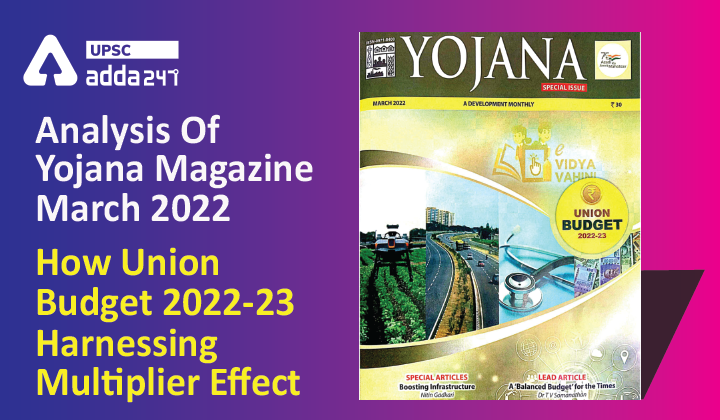Table of Contents
Analysis Of Yojana Magazine: ”Union Budget 2022-23 – Harnessing Multiplier Effect”
Relevance
GS 2: Federalism
GS 3: Government Budgeting
Introduction
- In the Union Budget 2022-23, tabled before the parliament on February 1 for the coming financial year, FM announced a 35.4% rise in outlay for capital expenditure, increasing it from ₹5.54 lakh crore to ₹7.50 lakh crore.
- The capital expenditure has thus increased to more than 2.2 times the expenditure of 2019-20 and it would be 2.9% of GDP in 2022-23.
- The emphasis on infrastructure development in the Union Budget 2022-23 will help ensure a greater multiplier effect, as well as create assets that will last for several years.
Why CAPEX Push?
- Studies say that capital expenditure has a multiplier effect of 2.45 crore in a short term and 4.8 crores in long term.
- So, every Rs 1 spent on CAPEX has a multiplier effect of Rs 2.45 worth of multiplier in the immediate year, and Rs 3.14 worth of effect in the following years.
What is Multiplier Effect?
- The multiplier effect is the proportional amount of increase or decrease in final income that results from an injection or withdrawal of spending.
- The most basic multiplier used in gauging the multiplier effect is calculated as the change in income divided by change in spending and is used by companies to assess investment efficiency.
- The money supply multiplier, or just the money multiplier, looks at a multiplier effect from the perspective of banking and money supply.
Impact Of Infrastructure Push on Core Sector Industries
- There is a significant push in the infrastructure sector, especially transport and logistics, while CAPEX expenditure has been raised by a whopping 35.4 per cent from Rs 5.54 lakh crore to Rs 7.50 lakh crore.
- This is likely to have a multiplier effect on the core sector industries like steel and cement, and in turn give a to boost the domestic refractory industry.
Long Term Vision
- The budget has chosen spending on infrastructure as the more favourable route to ensure greater multiplier effect, which will also result in asset creation which can last for several years.
- The Budget lays a blueprint for the next 25 years of India, up to India @ 100.
Key Benefits Of Capital Expenditure
- Creates Income Augmentation
- Creates Employment Opportunities
- Expands Ancillary Industries
- Enhances Future Productivity of the Economy
- Stimulates Demand
- Attracts Foreign Investment
Conclusion
Overall, this budget aims to create a long-term multiplier effect by focusing its resources and capital in the right direction. In future years, the government will need to stay the course set in the Budget, as the impact of these initiatives will be seen in the long term. This budget will fairly help leapfrog India’s economic development over the years to come.



 TSPSC Group 1 Question Paper 2024, Downl...
TSPSC Group 1 Question Paper 2024, Downl...
 TSPSC Group 1 Answer key 2024 Out, Downl...
TSPSC Group 1 Answer key 2024 Out, Downl...
 UPSC Prelims 2024 Question Paper, Downlo...
UPSC Prelims 2024 Question Paper, Downlo...





